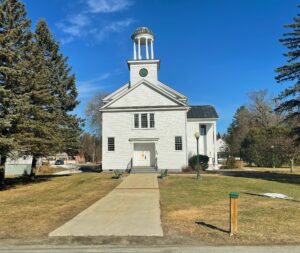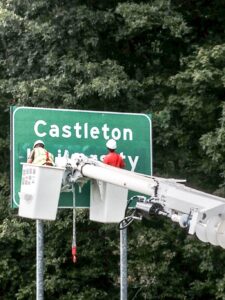What does merger mean for CU?

Castleton University is facing major changes in the coming semesters after the Vermont State Colleges System Board of Trustees officially voted in favor of the controversial merger of three of its subsidiary universities.
Passed on Feb. 22, the proposal was originally developed by the Select Committee on the Future of Public Higher Education in Vermont — a task force brought together under legislative order to address VSC’s growing financial issues. Plans are to combine Northern Vermont University, Vermont Technical College and CU into a singular entity.
Major goals of the transformation include increased integration of virtual learning to ensure state-wide access for students, a stronger and broader selection of academic programs and opportunities and an expansion of advising and student support services.
But talk of such changes has many in the Castleton University community worried for the future of the college’s well-established identity.
A Spartan Identity Crisis
Molly DeMellier, a 28-year old senior account executive in public relations, graduated from Castleton University in 2014 and worries that future students may not be able to have the same college experiences she did.
“Dave Wolk’s presidency spent almost two decades building this incredible brand that would help not only the university, but the entire local economy. And it absolutely accomplished that,” DeMellier said. “Now, I feel like this begins to undo that. It’s really disheartening, as an alum, to see.”
Statistics show, however, this isn’t the beginning of Castleton’s struggles with finances and enrollment rates.
Traditionally, Castleton University has relied heavily on Vermont students, and between 2001-2014 the school experienced a population growth from roughly 1,200 students to over 2,000 full-time undergraduates. In recent years, however, that number has decreased to around 1,800 — and has been further exacerbated by the pandemic.
Many within the Castleton community have said they wouldn’t be opposed to change given the lowered enrollment rates, with some caveats.
“As long as we can continue to call ourselves Castleton, we might actually benefit from increased marketing,” said Associate Dean of Students, Victoria Angis. “The University has changed name and affiliations many times over its long history. While the transition may be rough — change always is — in the long run, we will continue to thrive.”
VSC Chancellor Sophie Zdatny has admitted that substantial changes are on the horizon, but she pledges that the board and the Select Committee are committed to making the transition as seamless as possible.
“As we move forward over the coming months and years, we will work hard to ensure our current students feel minimal impact in their programs and coursework. Ensuring a transparent and smooth transition to a unified system, continuing access to robust financial aid, and providing the best opportunities to our students are top priorities,” Zdatny said in a Feb. 22 press release.
Financial future
Though there is division regarding the merger, most agree the current financial state of the university would make independence barely feasible. Since reporting a near $1.5 million deficit in 2018, Castleton University and the VSC board have been attempting to revamp the system.
Ryan Cooney is the current Vermont State Colleges System’s student trustee and an undergraduate at Vermont Technical College. He believes the merger is absolutely necessary for Castleton’s continued growth.
“A common accreditation for CU, VTC, and NVU is something that will have multiple benefits for students. An increase in savings, a more expansive offering of classes and opportunities, and a continued presence in each corner of the state are just some of the highlights of the transformation proposal,” Cooney said when asked his hopes for the merger.
However, alums and students have yet to be convinced that Castleton University won’t be giving more than they receive in the context of the merger.
“I understand the financial advantage of the merger, especially from the point of view of Northern Vermont University and VTC, as they need the most support,” said Class of ’90 Castleton alum, Terri Fassio. “I can also see that from Castleton’s perspective where they are the most dominant of the three institutions, they would be the most impacted on many levels. They would be giving up the most — both financially and the loss of their unique identity.”
Ben Thompson, a 20-year old psychology major at Castleton, agrees that Castleton’s identity is a major part of why he chose to pursue his undergraduate there, but he would like to see how a change in funding could elevate the school.
“The school budget and our wealth as a college [is] one of the biggest drawbacks to Castleton,” Thompson said. “Castleton has the potential to be one of the best schools in the Northeast — it just needs the funding and the allocation of those funds in a correct manner. I want to know how they plan to do that.”

The moniker matter
Rumors of a name change for the newly combined CU, NVU, and VTC have already begun circling, with questions regarding if this new, singular entity should have a shared name across its three campuses. The VSC Board of Trustees has suggested “Vermont State University at insert campus location here”— and people are not happy.
Former Castleton University President Dave Wolk composed a letter to The Castleton Spartan with former Dean of Advancement Jeff Weld on March 9 to relay how “changing Castleton’s treasured name to a division of Vermont State University (VSU) defies logic.”
The letter goes on to explain the great value students, faculty, and alum see in Castleton having university status and speaks to what many close to the institution are thinking.
“The seemingly haphazard renaming of these institutions deserves more thought and scrutiny,” Wolk and Weld wrote. “Castleton leadership did substantial research and pursued many years of building and strengthening the Castleton brand to prepare for its evolution to a respected university. The talented and caring faculty and staff brought the energy, enthusiasm, and educational rigor that ensured the brand was more than catchy slogans or shiny signs and facilities.”
Students agree that retaining the Castleton University name is much more than just an issue of rebranding. Thompson argued that university status has brought a whole new level of recognition to the school.
“It’s just so important to preserve that idea that [Castleton] is such a big part of Vermont’s educational history … We’re Castleton University. I decided to go to Castleton University,” Thompson said.
An opposing proposal
Though the VSC Board of Trustees voted to pass the Select Committee’s proposal for the merger of CU, NVU, and VTC, an additional proposal brought forth by the faculty driven Labor Task Force is still being advanced at the legislative level.
Helen Mango, a professor at Castleton and co-writer of the LTF proposal, said the committee has incorporated many of the LTF’s suggestions into the most recent version of the merger proposition — but more is needed.
“Both groups recognize that there has been a decades-long history of underfunding the VSC system. Since the 1980s, state funding has decreased from 51% of our operating costs to only 17.5%. As a result, tuition has had to go up and up and up, and this is driving down enrollment,” Mango said.
Major differences being fought by the LTF proposal proponents include social and civic impact studies, a model of shared governance, and the combination of all VSC institutions—including Community Colleges of Vermont. Advocates of the plan say communication between all community members is crucial.
“We don’t have anyone on the [Board of Trustees] that actually is ‘student-facing,’ so they don’t know what our students are going through,” said Castleton professor Linda Olson.
Olson, who co-authored the LTF proposal, said she believes communication between all of the VSC schools could provide for a fuller, more widely available set of course offerings for both Vermont and out-of-state students.
“If you had a real interest in taking an atmospheric science class at NVU, you could do that as a Castleton student, even though you’re housed at Castleton. It would be a way that our students can get access to more opportunity seamlessly,” Olson said.
What’s next?
It is clear that the COVID-19 pandemic has forced colleges across Vermont into a state of financial frenzy. With an already teetering annual rate of enrollment across VSC universities, a transformation of some sort is imperative to the success of all three colleges, officials agree.
“I think it is too early to understand the full impact, nor the full benefit of the merger. Higher education is in an extreme transformational period, no one can deny that reality,” said Dean of Students, Dennis Proulx. “I sit on the fence mourning on one side what could be lost, and on the other feeling the excitement of innovation and collaboration that this opportunity will bring. I know there is no going back, so I must focus on the future.”
But the subject of a merge between three accredited Vermont universities is a tough one to chew on for many. The merging of these institutions brings with it a host of questions about what exactly the combination will entail. Will there be campus changes? New classes? Cheaper tuition?
The truth is, answers to those questions don’t come easy, though most are trying to assure students their lives won’t change.
“The board approving the committee’s proposal was only the first step in a very long list of decisions that will need to be made. We’re just getting started in this process,” said Associate Dean of Advancement, James Lambert. “I don’t think students will experience too much of a change on campus — and change won’t be immediate. Much of the work is going to be the behind-the-scenes administrative changes. The board is working to be as transparent as possible with everything that’s going to be happening.”
With rumors of complete campus overhauls and a loss of individual college identities, students and alums feel similarly to Proulx — expecting a different Castleton, but hopefully one that remains “home.”
Jasper Lynch, a 20-year old art education major at Castleton, worries that a consolidation of administration and of campus offerings may completely change Castleton and campus life, but he feels as though more information from the source of the merge would allow students to weigh in.
“I think it’s a cool idea, but I feel like each [college] is so different with their own things that they do, their own specialties. And I think it’s going to be kind of hard for one college to try and run all of that. Also, I don’t know what they’re going to do with the campuses,” Lynch said. “Basically, I feel uniformed. I also at the same time feel like I’m not going to be too affected by the change. And I’m not sure that I’m happy about either of those things.”
– Perry Howard contributed to this story.








